


VI. Analysis of Data Products
3. Photometric Properties
e. Extended Source Photometry
The pipeline includes cross-matching the WISE source positions with that of the 2MASS Extended Source Catalog (XSC).
Sources that are in close proximity (xscprox <= 2 arcsec) to 2MASS XSC sources are assumed to be associated (i.e., the same source), and special
aperture photometry is triggered for the source. The aperture is based on the elliptical shape that the 2MASS XSC reports. Due to the larger WISE beam, however, the aperture is adjusted (scaled) accordingly; more details are given in section IV.4.c.
Finally, note that sources that are resolved in 2MASS may not necessarily be resolved by WISE, particularly in the long wavelength
bands (e.g., see below, Fig. 2).
Examples of resolved galaxies with the scaled-2MASS aperture:
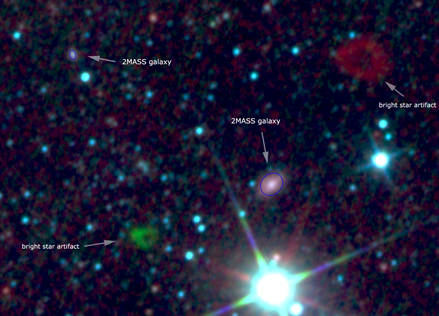 |
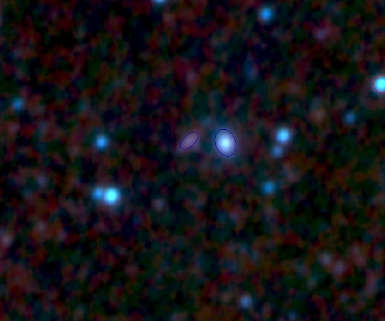 |
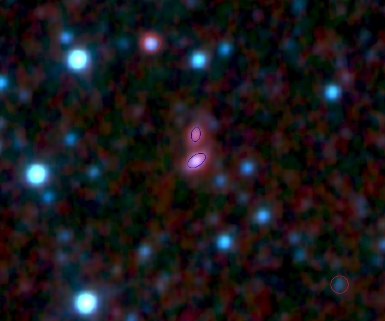 |
| Figure 1a - WISE W1+W2+W3 composite image showing the
elliptical aperture (blue) used to extract the flux from 2MASS galaxies in the field.
|
Figure 1b - Blue-red galaxy pair |
Figure 1c - Red-red galaxy pair. |
The examples clearly show that the scaled-aperture is too small by 10 - 20% for well resolved
sources, resulting in
an underestimate of the integrated flux (by about 30-40%).
To quantitatively assess this deficiency,
Cluver, Jarrett & Leschinski (2012)
compiled a list
of ~550 resolved galaxies (w1rchi2 > 2.0), located in the Galaxies and Mass Assembly (GAMA;
Driver et al., 2011, MNRAS, 413, 971) G15 field:
211.5 < RA < 223.5 ; -2.0 < DEC < 2.0 (glon,glat ~ 346.077, 54.923 deg),
carefully measuring the integrated flux of the resolved galaxies. The extraction method is described
in Jarret et al. (2012, AJ, 144, 68) and entails removal of foreground stars, local background
estimation, elliptical apertures fit to the 1-sigma isophote, surface brightness characterization
and extrapolated, total photometry. A "best" estimated magnitude is extracted from
the isophotal or small-aperture measurement, depending on how extended the object is
in the WISE bands. In the following plots, we show the difference
between this "best" photometry and the WISE scaled-2MASS-aperture photometry.
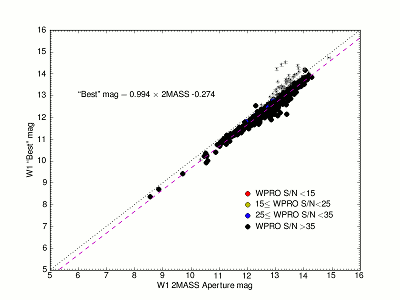 |
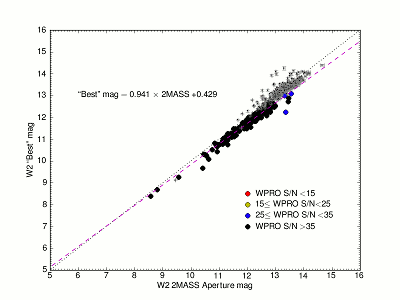 |
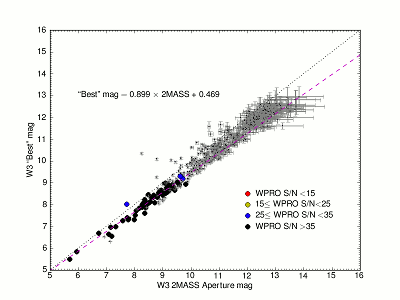 |
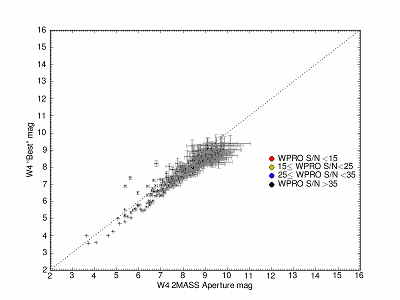 |
| Figure 2a -
W1 photometry of resolved galaxies (filled points). Unresolved sources are indicated
by small points and grey error bars. The X-axis shows the WISE pipeline measurement
using a scaled-aperture based on the 2MASS XSC parameters.
The Y-axis shows the "best" measurement that is either the 1-sigma isophotal integrated magnitude
or a small-aperture magnitude (depending on the size and S/N of the object).
There is a clear offset between the two measures, the best fit linear relation is
specified in the plot; the WISE pipeline measurement is
systematically fainter by ~0.35 mag.
|
Figure 2b - W2.
There is a clear offset between the two measures: the WISE pipeline measurement is
systematically fainter by ~0.28 mag. |
Figure 2c - W3.
There is a clear offset between the two measures: the WISE pipeline measurement is
systematically fainter by ~0.44 mag. |
Figure 2d -
There are no resolved sources extracted in the W4 band.
|
For regions located well away from the Galactic Plane where foreground confusion is
fatal to simple aperture photometry, the scaled-2MASS aperture photometry
provides a flux that may be corrected to give a result that's ~20% within
the true integrated flux of a resolved galaxy.
The important caveat is that the scaled-2MASS aperture photometry does
not include foreground source subtraction, and so contamination from nearby
sources is always a factor to be reckoned with.
Last update: 2013 July 29








